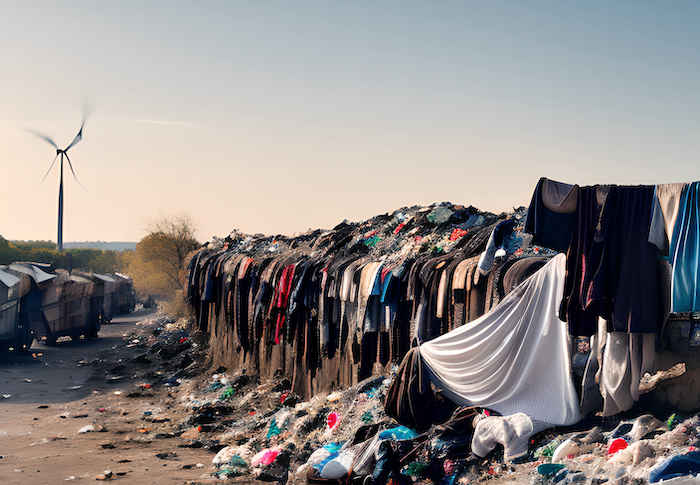
Fashion in today’s society reveals the sad truth. People often throw away clothes after only wearing them a few times. The idea of being an “outfit repeater” in today’s world is looked at negatively.
Consumers typically follow the latest trends, and retailers have picked up on that. Now, retailers are focused on producing clothing as fast as possible, aka the fast fashion problem, a phenomenon that’s become a boon for the fashion industry, but also a hindrance to the environment.
Fast Fashion’s Impact on The Environment
**Click to auto scroll by section.
What Is Fast Fashion?
Around 30 years ago, shopping for clothes typically happened a few times a year, specifically when the seasons change. Now, however, it’s drastically different. Shopping has become a hobby and online shopping has been a catalyst for fast fashion to grow drastically, making the need for clothes to be produced quickly.
Fast fashion has been going on for years as more and more people want to wear the latest styles. Clothing is often made from cheap materials that aren’t purchased, which allows for increased production to keep up with demand.
Why Fast Fashion Is Bad
Over time, the public has woken up to see the dark side of fast fashion, both with pollution in the environment and the strain of manual labor.

Fast Fashion’s Negative Environmental Footprint
The old saying “one’s gain is another’s loss” is certainly true in the fashion industry, where large companies reap the benefits of boosted production of textiles and clothing to keep up with demand, while the environment ultimately suffers with fashion pollution.
The biggest example of this can be seen in fast fashion’s production.
Fast Fashion Statistics
The textile production, manufacturing and distribution makes up about 10% of carbon emissions, pollutes water sources and more. Moreover, 85% of textiles and other fashion waste ends up in a landfill each year.

Negative Labor Costs
Fast fashion also places a heavy burden on laborers. A large majority of workers are often paid extremely low wages and forced to work long hours in difficult conditions. Typically, you’ll find that these workers are women and in some cases, children, located in developing countries.
Fast Fashion Environment Impact: The first catastrophe in the fast fashion industry was in 1911, when a fire broke out in New York’s Triangle Shirtwaist Production Line, killing 146 workers, many of which were young female immigrants. In 2013, a Rana clothing manufacturing plant collapsed in Bangladesh killing over 1,000 workers, just a few of the many examples throughout history.
Use The Minimalist Mindset To Combat Fast Fashion
While we may be a ways away from solving the fast fashion crisis as a whole, you can personally make changes in your everyday lives, taking steps to live in an eco-friendly way.
A great way to start is to develop a minimalist mindset in your life, dealing with your closet.
Minimalist Closet Ideas

- There’s Nothing With Repeating Outfits: If you wear the same shirt you wore last week, lets be honest. No one really cares. And if they do, who cares.
- Hold On To Your Comfortable Clothes: Dressing for comfort rather than style can go a long way in cutting down on your wardrobe. Use fabrics you like and throw out the rest.
- Donate Your Unwanted Clothes: If your clothes are still in good condition, donate them to a friend, family member or even a charity like the Salvation Army or Goodwill.
- Find A Good Tailor: If you find clothes you like but they don’t fit, don’t scramble to look for different sizes. A good tailor can help you out to make it fit!
- Do A Wardrobe Audit: Lastly, do a sweep of your closet. Chances, are, you have plenty of clothes you never wear. Don’t be afraid to purge when needed.
- Support local thrift stores: Support your local stores first! A lot of thrift shops like Goodwill will have clothing you can purchase that was passed down from someone else.
- Buy, sell and trade your clothes online: You can easily find cool clothing to buy, sell or trade from marketplaces online like Facebook, eBay, Craigslist and much more!
- Make purchases with sustainable brands: Try only buying brands that advertise as sustainable companies such as Patagonia, Pact, Reformation, Everlane and much more.
- Upcycle your clothes: Transform your old clothes into new outfits or even entirely new items just by cutting and sewing used garments and textiles.
- Borrow instead of buy: Need a dress for a special occasion? Jacket for a ski trip? Just borrow from a friend! You can also rent clothes from outlets, as well.
More Alternatives to Fast Fashion
Though it may not seem that obvious these days, there are definitely ways to find affordable, sustainable clothing. Shopping ethically can not only help support the environment long term, but you can actually save money.
How To Avoid Fast Fashion On A Budget
Want to donate clothes? LEARN MORE
Shopping ethically doesn’t mean you need to change your style. Rather, it’s about being resourceful to use what you already have!
Local Services Can Help Customers Give Back
Defeating the negative effects of fast fashion won’t happen overnight, but rather by a individual collective effort over time to alleviate the strain this industry puts on the environment.
Local junk removal companies, like LoadUp, have adopted sustainable methods to dealing with waste. Our professionals will consistently seek out eco-friendly solutions for disposal, such as donation and recycling.
So, next time you (or even your business) need to get rid of materials from producing clothing from your factory or even at-home DIY project, call on professionals to help you haul away clothing, cardboard, textiles or any material so it doesn’t end up in a landfill, contributing to fast fashion’s already existing problem.
Related Articles from the Trash Talk Blog:

